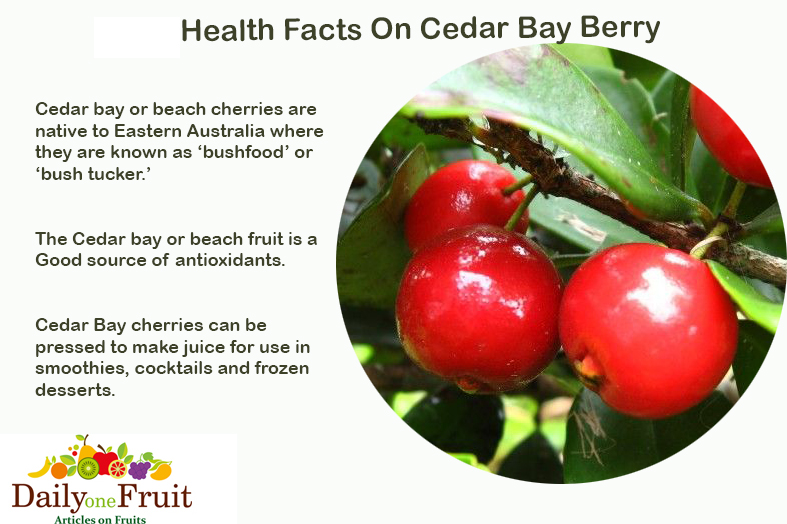
Facts on Cedar Bay Berry
Cedar bay cherry is scientifically called as “Eugenia reinwardtiana” .
ORIGIN ON CEDAR BAY BERRY
Cedar bay cherry is a shrub to small tree in the family Myrtaceae, ( Native to tropical forests in northern Queensland, Australia; Indonesia, and the Pacific Islands ).
They are typically 2 to 6 m (6.6 to 19.7 ft) in height.
OTHER NAMES ON CEDAR BAY BERRY
Beach Cherry, Australian Beach, Mountain Stopper, and Nioi (Hawaii), ‘ bushfood ’ or bush tucker.
APPEARANCE ON CEDAR BAY BERRY
Cedar Bay cherries have a rounded, bulbous shape and measure approximately 1 inch in diameter. Cedar Bay cherries exterior skin is smooth and shiny exhibiting a bright orange-red hue. Cedar Bay cherries soft flesh is juicy and surrounds a cherry-like pit.
TASTES ON CEDAR BAY BERRY
The Cedar Bay cherries fruits are green at first, when ripe it turns to a bright orange-red colour, these fruits are also taste sweet and delicious with its soft flesh.
VARIETIES ON CEDAR BAY BERRY
• Eugenia carissoides F.Muell.
• Eugenia hypospodia F.Muell.
• Eugenia kangeanensis Valeton
• Eugenia macrohila C.T.White & W.D.Francis
• Eugenia rariflora Benth.
• Eugenia waianensis O.Deg.
• Jossinia reinwardtiana (Blume) Blume
• Jossinia tahitensis Nadeaud
• Myrtus reinwardtiana Blume
NUTRITIONAL CONTENTS ON CEDAR BAY BERRY
Principle Nutrient Value per 100g Percentage of RDA
Cherry type Sweet Tart Sweet Tart
Carbohydrates 16.1 g 12.18 g 12% 9%
Protein 1.06 g 1.00 g 2% 2%
Dietary Fibre 2.1 g 1.6 g 5.5% 4%
Vitamins
Vitamin C 7 mg 10 mg 11% 17%
Vitamin A 640IU 1283 IU 21% 43%
FACTS ON CEDAR BAY BERRY
Cedar bay or beach cherries are native to Eastern Australia where they are known as ‘bushfood’ or ‘bush tucker.’ There are still about 1000 Eugenias in other parts of the world;
Cedar bay named after the Cedar Bay in the Daintree rainforest region. Cedar bay fruit is sometimes cultivated but is more commonly found growing wild.
ABOUT CEDAR BAY BERRY TREE
The Cedar Bay cherries is cultivated to a limited extent for its edible sweetish fruit that is often used to flavour drinks and candies. The Cedar bay or beach fruit is a source of antioxidants.
Cedar Bay Leaves are lanceolate and vary from 2 to 9 cm long and 1-5 cm wide. Flowers are solitary in the leaf axils . Cedar Bay Fruit is a fleshy red berry, but may be elliptical about 2 cm long.
• Cedar Bay cherries are considered a tropical cherry ideal for eating fresh snacks as fruits, and appear in many preparations ,cooked down to make jam, chutney, and pie filling.
• Cedar Bay cherries can be pressed to make juice for use in smoothies, cocktails, and frozen desserts. To store, keep Cedar Bay cherries refrigerated and use within one week of harvesting